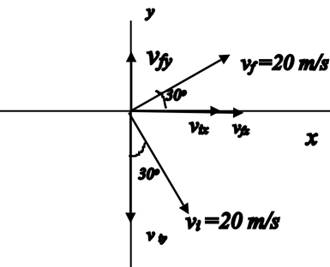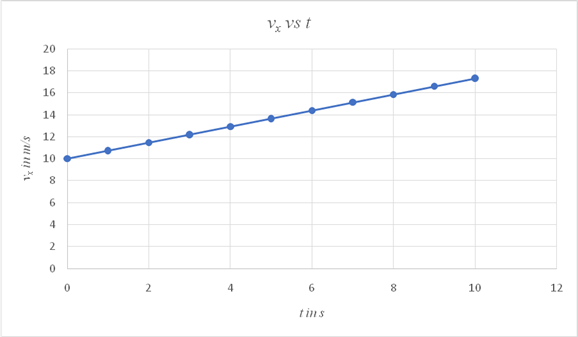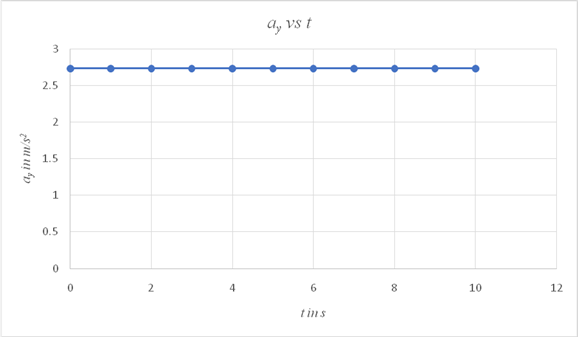
Concept explainers
(i) The x component of the velocity versus time
(ii) The y component of the velocity versus time
(iii) The y component of the acceleration versus time.
Explanation of Solution
Given info:
Magnitude of the initial velocity
Angle made by vi with x- axis
Magnitude of the final velocity
Angle made by vf with x axis
Time interval during which the velocity changes
Formula used:
The components of the velocity vectors along the x and the y directions are given by,
The change in velocity along the x and the y directions is given by,
The components of the acceleration along the x and y directions are given by,
The equation to determine the variation of
The equation to determine the variation of
Calculation:
Resolve the vectors vi and vf along the x and the y axes. This is shown in the diagram below.

The components of the velocity vector vi are directed along +x and-y axes, hence the y component is assigned a negative sign. Calculate the magnitude of the components substituting the values of the variables in the equation,
The components of the final velocity vector vf are directed along the +x and +y directions, hence the components are positive. Calculate the magnitude of the components of the vector vf using the values of the variables.
Calculate the change in velocity along the x and the y directions.
Calculate the components of the acceleration along the x and the y directions.
Using the values of vix and ax in the equation
Plot a graph showing the variation of vx with time.
| t in s | vxin m/s |
| 0 | 10 |
| 1 | 10.732 |
| 2 | 11.464 |
| 3 | 12.196 |
| 4 | 12.928 |
| 5 | 13.66 |
| 6 | 14.392 |
| 7 | 15.124 |
| 8 | 15.856 |
| 9 | 16.588 |
| 10 | 17.32 |

Using the values of viy and ay in the equation
Use the equation in a spread sheet and plot the graph showing the variation of vy with time t.
| X-Values | Y-Values |
| 0 | -17.32 |
| 1 | -14.588 |
| 2 | -11.856 |
| 3 | -9.124 |
| 4 | -6.392 |
| 5 | -3.66 |
| 6 | -0.928 |
| 7 | 1.804 |
| 8 | 4.536 |
| 9 | 7.268 |
| 10 | 10 |

The y component of the acceleration ay is independent of time, since the object's acceleration remains constant during the time interval.
Plot a graph showing the variation of ay with time t.
| t in s | ayin m/s2 |
| 0 | 2.732 |
| 1 | 2.732 |
| 2 | 2.732 |
| 3 | 2.732 |
| 4 | 2.732 |
| 5 | 2.732 |
| 6 | 2.732 |
| 7 | 2.732 |
| 8 | 2.732 |
| 9 | 2.732 |
| 10 | 2.732 |

Conclusion:
The graph showing the variation of vx with time is linear and the value increases from 10 m/s to 17.32 m/s at the end of 10 s.
The graph showing the variation of vy with time is also linear and its value increases from -17.32 m/s to reach a value of 10 m/s at the end of 10 s.
The graph showing the variation of ay with time is a straight line parallel to the time axis, showing that its value is invariant with time.
Thus all the results are consistent with an object moving with a constant acceleration during the time interval of 10s.
Want to see more full solutions like this?
Chapter 3 Solutions
COLLEGE PHYSICS,VOLUME 1
- The world long jump record is 8.95 m (Mike Powell, USA, 1991). Treated as a projectile, what is the maximum range, in meters, obtainable by a person if he or she has a take-off speed of 8.2 m/s? Assume the motion is over level ground and the initial velocity makes an angle of 45° with the horizontal.arrow_forwardA Lockheed Martin F-35 II lighting jet takes off from an aircraft carrier with a runway length of 90 m and a takeoff speed 70 m/s at the end of the runway. Jets are catapulted into airspace from the deck of an aircraft carrier with two sources of propulsion: the jet propulsion and the catapult. At the point of leaving the deck of the aircraft carrier, the F-35’s acceleration decreases to a constant acceleration of 5.0m/s2 at 30 with respect to the horizontal. (a) What is the initial acceleration of the F-35 on the deck of the aircraft carrier to make it airborne? (b) Write the position and velocity of the F-35 in unit vector notation from the point it leaves the deck of the aircraft carrier. (c) At what altitude is the fighter 5.0 s after it leaves the deck of the aircraft carrier? (d) What is its velocity and speed at this time? (e) How far has it traveled horizontally?arrow_forwardA celebrated Mark Twain story has motivated contestants in the Calaveras County Jumping Frog Jubilee, where frog jumps as long as 2.2 m have been recorded. If a frog jumps 2.2 m and the launch angle is 45, find (a) the frogs launch speed and (b) the time the frog spends in the air. Ignore air resistance.arrow_forward
- Position, Displacement, and Average Velocity Give an example in which there are clear distinctions among distance traveled, displacement, and magnitude of displacement. Identify each quantity in your example specifically.arrow_forwardIs it possible for velocity to be constant while acceleration is not zero? Explain.arrow_forwardWhen the pilot reverses the propeller in a boat moving north, the boat moves with an acceleration directed south. Assume the acceleration of the boat remains constant in magnitude and direction. What happens to the boat? (a) It eventually stops and remains stopped, (b) It eventually stops and then speeds up in the forward direction, (c) It eventually stops and then speeds up in the reverse direction, (d) It never stopsarrow_forward
- A blue person throws an object with an initial velocity of 25.0 m/s at an angle of 37.0°. A green person stands 15.0 meters in front of the blue person and throws an object straight up. Assume that both objects are thrown from the same initial elevation. a)If the green person throws their object with an initial speed of 20.0 m/s, at what time should they throw it such that it strikes the other object while it is traveling upward? Measure this time relative to when the blue person throws theirobject? Answers: a) ~0.267 sarrow_forwardWhile warming up before the match, Serena Williams is gently bouncing a tennis ball up and down on her racket. She then gives it a powerful upward hit from an initial height of 0.80 m and sends it traveling perfectly vertically. After rising to its maximum height, the ball falls back down to the court. Given that the ball was in the air for a total of 1.91 s, determine its velocity upon hitting the court.arrow_forwardA ball is kicked with an initial speed of 40 m/s at an angle of 30 degrees from the top of a 500m cliff. How fast is the ball moving just before it hits the ground? Answer using kinematics.arrow_forward
- Option 2 1. The body, vertically down with an initial speed of 5 m/s, in the last 2 s of the fall, the path went twice as much as in the previous 2 s. Determine the time and height of the fall.arrow_forwardA football player carrying the ball runs straight ahead at the line of scrimmage and directly into a wall of defensive linemen. The ball carrier has an initial speed of 8.00 m/s and is stopped in a time interval of 0.200 s. Find the magnitude and direction of his average acceleration.arrow_forwardA ball is thrown vertically upward, which is the positive direction. A little later it returns to its point of release. The ball is in the air for a total time of 7.96 s. What is its initial velocity? Neglect air resistance. v0 =arrow_forward
 Physics for Scientists and Engineers, Technology ...PhysicsISBN:9781305116399Author:Raymond A. Serway, John W. JewettPublisher:Cengage Learning
Physics for Scientists and Engineers, Technology ...PhysicsISBN:9781305116399Author:Raymond A. Serway, John W. JewettPublisher:Cengage Learning Principles of Physics: A Calculus-Based TextPhysicsISBN:9781133104261Author:Raymond A. Serway, John W. JewettPublisher:Cengage Learning
Principles of Physics: A Calculus-Based TextPhysicsISBN:9781133104261Author:Raymond A. Serway, John W. JewettPublisher:Cengage Learning College PhysicsPhysicsISBN:9781938168000Author:Paul Peter Urone, Roger HinrichsPublisher:OpenStax College
College PhysicsPhysicsISBN:9781938168000Author:Paul Peter Urone, Roger HinrichsPublisher:OpenStax College University Physics Volume 1PhysicsISBN:9781938168277Author:William Moebs, Samuel J. Ling, Jeff SannyPublisher:OpenStax - Rice University
University Physics Volume 1PhysicsISBN:9781938168277Author:William Moebs, Samuel J. Ling, Jeff SannyPublisher:OpenStax - Rice University College PhysicsPhysicsISBN:9781305952300Author:Raymond A. Serway, Chris VuillePublisher:Cengage Learning
College PhysicsPhysicsISBN:9781305952300Author:Raymond A. Serway, Chris VuillePublisher:Cengage Learning




